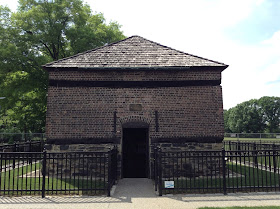Very little remains of the first two forts that were established at the junction of the Allegheny and Monongahela Rivers at what is now the City of Pittsburgh. This was an extremely important site, because it controlled the headwaters of the Ohio River, which in turn was one of the main superhighways into the lands west of the Appalachian Mountains. Nothing at all remains of the American Fort Fayette, from which the Lewis and Clark Expedition was launched and American armies as far flung as Detroit and New Orleans were supplied during the War of 1812.
Around the beginning of the 19th century, the French fort had vanished and the British Fort Pitt was in ruins.
A plan of Fort Fayette.
The modern site of the fort, on the river in downtown Pittsburgh.
The French outpost Fort Duquense, built in 1754 and captured by the British in 1758.
Today a small cross-section of Fort Pitt's curtain wall has been reconstructed, almost in the shadow of a modern highway. It houses the Fort Pitt museum.
Since the museum was erected in the 1960s, many of the paintings illustrating the fort are themselves objects of historical curiosity. The style reminds me of jet-age concept art for Walt Disney's theme parks.
The museum has plenty of great displays, such as this Western Pennsylvania or Virginia militiaman, armed with a rifle.
Drab items, such as this hunting shirt or frock, are actually extremely rare, simply because no one thought to save them as relics.
Likewise, canteens were an extremely common, but now very rare item.
An early swordsmith in Pittsburgh made this sabre. Perhaps it was carried by an officer or cavalryman during the War of 1812.
A closer view of the pommel. Officer's swords, oddly enough, are less valuable as relics because they were far more likely to be preserved and passed on. I don't think I have ever seen one of the ordinary swords issued to enlisted sergeants or musicians, but you can buy officer's swords from the period on ebay...
Both the Heinz Center and the Fort Pitt museum had a lot of bronze ordnance. The two 6-pounders at Fort Pitt were apparently owned by the State of Pennsylvania after having been manufactured for the King of France and serving at the Siege of Yorktown. Nice pieces, too-- I wouldn't mind firing one...
By far the most striking was "the ambusher", a bronze 6-pounder with open sights!
That's right, you can aim this piece by lining up the rear and front sights, just like a rifle. Most cannons of the period either used a detachable sight, or more often were aimed by the gunner placing his thumbs parallel to create a rear sight out of his thumbnails, then sighting along an imaginary line through the middle of the muzzle swell. Crude, but it actually worked quite well for direct fire, as many headless sailors and soldiers can no doubt attest.
Nec Pluribus Impar "not unequal to many", the mysterious motto of King Louis XIV, above a representation of the Sun King himself. While uncertain, some scholars think that the slogan means "I can take on all of Europe by myself" which was certainly true of 17th and early 18th century France.
Ultima ratio regium "The last argument of kings". Touche, King Louis...
The front sight even has a wisp of leaf cast into it. Since bronze molds had to be destroyed after one casting, these guns were expensive and state of the art to manufacture. It was worth it for field guns because bronze was much lighter than the iron equivalent.
There's another hole near the original vent. Maybe it was drilled when the original vent wore out and needed to be filled, or maybe someone tried to put a gun lock or something there...
The dolphins, a common feature of cannons like these. They were used to dismount and mount the gun tube, either with a tripod and winch or with handspikes and muscle.
The only standing remnant of the forts here was a blockhouse, added to the outerworks of the fort in the 1760s.
The blockhouse was built of brick and so sturdy that it was used by generations of families as a tenement house long after the fort was demolished.
The original stone is inscribed with the name of Colonel Henry Bouquet, commander of Fort Pitt during Pontiac's War of 1763-4. During the war, British commander Jeffrey Amherst ordered him to try to spread Smallpox among the tribesmen by giving them contaminated blankets. Bouquet wrote: "I will try to inoculate the Indians by means of blankets that may fall
in their hands, taking care however not to get the disease myself."[2] This was the first modern instance of biological warfare. The following year Bouquet died in West Florida, apparently not from smallpox...












No comments:
Post a Comment
Note: Only a member of this blog may post a comment.